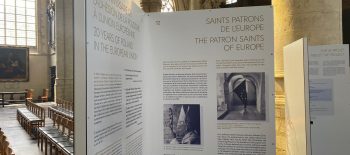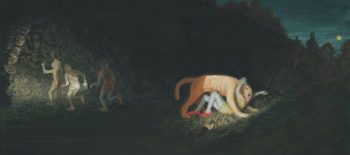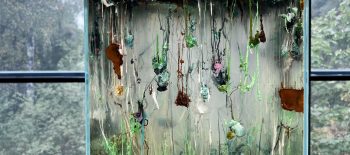Thursday 27th January 2022 at 7.30 pm
@ Chapelle Protestante / Protestantse Kapel (Museumplein 2, 1000 Brussels)
More details on the Facebook event.
Reservation here (recommended due to a limited number of seats).
Prisoner Orchestra in Birkenau (1942-1944)
by Jacek Lachendro
The Konzentrationslager (German: concentration camp, KLJ Auschwitz) was opened in the spring of 1940. In the years that followed, it was systematically expanded, so that it eventually consisted of three main parts: Auschwitz I (the main camp), Auschwitz II (Birkenau), and Auschwitz III (Monowitz), as well as over 40 sub-camps.
There were four prisoner orchestras in the Auschwitz complex, whose main task was to play marching melodies to facilitate the prisoners’ departure for work and their return to the camp. Their duties also included giving concerts for SS men, usually on Sunday afternoons, and, with permission from the camp administration, for fellow prisoners. The first orchestra was formed in March 1941 in Auschwitz I. Over time, it grew to number about 120 musicians and functioned, barring a short period of suspension, until the closure of the camp (at the end of 1944, it numbered about 80 prisoners). The other orchestras played in Birkenau both in the men’s camp and in the women’s camp, as well as in Monowitz. The men’s ensembles numbered 30-40 people, while the women’s ensemble numbered more than 40. In addition, there were four small music ensembles in various sectors of Birkenau that played for the entertainment of SS men and functionary prisoners, and sometimes for fellow prisoners. Similarly, in the seven larger sub-camps, there were several ensembles of about a dozen people. Their main task was to play, usually on Sundays, for SS men and prisoners.
The orchestra in the men’s camp in Birkenau was formed in August 1942 at the request of Lagerführer (camp director) Johann Schwarzhuber. It initially consisted of 16 prisoners transferred from the orchestra in the main camp. As was the case with the other bands, its primary task was to play lively marches to maintain the rapid pace at which the working prisoners passed through the camp gates. The orchestra gradually grew in size and in the summer of 1944, it was made up of over 30 musicians. Initially, it consisted only of Poles, but their number was not large. Therefore, with the consent of the camp manager, Jews were also accepted into the orchestra and, as a result, they began to dominate the “band”. Among them, there were excellent musicians such as Szymon Laks and Louis Bannet (a jazz musician known as the Dutch Armstrong), whose inclusion raised the level of playing and improved the sound.
The first kapellmeister and conductor of the orchestra was a Pole, Jan Zaborski, who also played the tuba (prisoner number 19848). After his death in November 1942, these roles were taken over by the drummer, also a Pole, Franciszek Kopka (prisoner no 11099). He led the orchestra until June 1944 when, as a Reich citizen (Reichsdeutsch), he was released from the camp. However, by that time, Szymon Laks (prisoner no 42543), a Polish musician with Jewish roots, deported from France in July 1942, had already gained a significant impact on the functioning of the band. This was undoubtedly influenced by his thorough education and great abilities. He had studied composition and conducting at conservatories in Warsaw and Paris, thanks to which he was not only a great conductor, but also an excellent orchestrator, who skillfully wrote down scores for the whole ensemble.
The musicians changed the barracks where they lived and rehearsed several times. However, they spent the longest in the barrack number 5 in sector BIb, and in the barrack with the same number in sector BIId. In both sectors, they played for the work committees while being positioned near the camp gates. Usually, they also gave Sunday concerts for the SS and fellow prisoners in those spots.
The regular repertoire consisted mainly of German marches. On Sundays, on the other hand, the orchestra members played pieces of classical music, predominantly by German and Austrian composers, as well as popular hits of the time. From time to time, there were informal performances for SS men or privileged prisoners, during which the musicians also played American jazz music. Although this music was considered “degenerate” in the Third Reich and playing it on the radio or in clubs was forbidden, certain musicians played it at the request of some of the SS men during social gatherings. The musicians, however, did not perform works by Polish composers, such as Chopin, or by Jewish ones, since those were forbidden in the camp. If they did, it was only unofficially, in a small, trusted circle of people.
The men’s orchestra in Birkenau existed until the end of October 1944, when its members were deported, mainly to KL Sachsenhausen
Jacek Lachendro, PhD, the Vice-Head of the Research Centre at the Auschwitz-Birkenau State Museum. Outstanding historian, author of several important publications, among others the album Auschwitz after Liberation and of the crucial text on the camp orchestras published in Auschwitz Studies.
_______________________
Jacek Lachendro, The orchestras in KL Auschwitz, Auschwitz Studies 27, 2015, p. 7-148
Szymon Laks, Music of Another World, Evanston, IL: Northwestern University Press, 1989
Ken Shuldman, Jazz Survivor, The Story of Louis Bannet, Horn Player of Auschwitz, London, Portland 2005 Forbidden Music website https://forbiddenmusic.info/en/forbidden-music
Music as Remembrance
by Katarzyna Naliwajek
The third quartet by Szymon Laks and the famous Schubert’s string Quintet are performed at the Chapelle Protestante in Bruxelles by the Karski Quartet and the cellist Raphael Wallfisch to commemorate the liberation of the Auschwitz concentration camp on the 27th of January 1945 and the Holocaust Remembrance Day.
Szymon Laks – composer, violinist, author, publicist, and translator – was born in Warsaw in a Jewish family on 1 November 1901. After studying mathematics, philosophy, composition and conducting in Warsaw, he moved to Paris, just like so many other young Polish composers. There his musical creativity was violently halted on 14 May 1941, when he was arrested, detained in transit camp in Pithivier and on 19 July 1942 transported to Auschwitz II Birkenau, where he received number 49543. He managed to survive the tragic conditions there as musician and conductor of the camp’s orchestra. In October 1944 he was transported first to Oranienburg-Sachsenhausen, and in November to Dachau’s subcamp Landsberg/Kaufering, where he worked at the construction site of a military planes factory.
Upon his return to Paris on 18 May 1945, he began to describe his camp experiences. The Polish edition of this book (Gry oświęcimskie, 1979; originally published as Musiques d’un autre monde in 1948) was dedicated to his friends, who helped him survive the camp – Ludwik Żuk-Skarszewski, Tadeusz Jaworo and Jan Stojakowski. At the same time he composed his third string quartet ‘on Polish folk themes’ (‘sur des motifs populaires polonaises’), performed by Quatuor Lespine on 25 November 1945 at the Sorbonne. This quartet is the credo of the composer, whose outstanding pre-war output was destroyed at the time of this arrest (among them the two first string quartets and the Blues symphonique for saxophone and orchestra), and who strives to regain his artistic identity and to recover his énergie vitale by referring to several folk melodies of his homeland. Twenty years later, being again overwhelmed by the global political situation and the recurring antisemitism, he returned to this quartet and built on it his superb Piano Quintet (1967).
The music of Szymon Laks, erased from the music scenes during the Holocaust, has been regaining its proper place only during the last decade, thanks to the efforts of musicians, such as the legendary Silesian String Quartet, the Canadian ARC Ensemble, the Szymanowski Quartet and the conductor Szymon Bywalec, musicologists and the visionary organisers, as Frank Harders-Wuthenow, who has realized a series „Poland Abroad” with music by Polish musicians victims of National Socialists’ persecution, and Renata Koszyk, founder of the site Forbidden Music (Zakazana muzyka; https://forbiddenmusic.info/) and producer of recordings of music played by prisoners of the Auschwitz-Birkenau camp (women’s and men’s orchestras, which functioned there).
The String Quintet in C major, is the last chamber work written by Franz Schubert, completed just two months before his premature death in 1828. It is often referred to as the ‘Cello Quintet’, due to its unusual scoring, where a cello is added to the string quartet in place of a more standard scoring with second viola. Thus intensified lower register creates more poignant colors and effects. It is the second of its four movements, the intensely moving Adagio, which is often considered as the highest expression of mourning.
The Karski Quartet – violinists Kaja Nowak and Natalia Kotarba, violinist and violist Diede Verpoest and cellist Julia Kotarba – founded in Belgium in 2018, is gaining recognition for its passionate approach in their interpretations of music ranging from 18th to 21st centuries. The Quartet takes its name and ideals from Jan Karski (1914-2000), the legendary resistance hero, who began his career as Polish diplomat before the war and whose mission was to discover and reveal the truth about the Holocaust in occupied Poland to the Allies politicians in 1942 and 1943, and whose voice and testimony were not listened to.
Raphael Wallfisch is a celebrated cellist, whose mother, Anita Lasker-Wallfisch, outstanding cellist as well, played cello in women’s orchestra in Birkenau, and was friend of late Helena Dunicz-Niwińska, who played violin there, and thanks to whom a reconstruction of Chopin’s Etude E major in the scoring by Alma Rosé, who conducted the women’s orchestra and thus protected women there, and gave them this score to be played for themselves in secret, was performed and recorded.
In his book published two years before his death in 1983 in Paris, Szymon Laks wrote that although memories of the camp have not faded away, the anger, pity, fury, revolt, and the call for revenge ‘have gradually lost their strength, to eventually perish, like a morning mist after sunrise’. And in the Mandatory Warning, the introduction to his last book, published posthumously in 1984, he described the notion of culture as – among others – ‘brotherly love’ and ‘the respect for opinions of the others – racist ones exempt’.
Let these ideas resound not only during this concert and on this special day, but in our societies and in men’s hearts thanks to musicians, artists and different actions promoting better understanding between individuals, nations and states.
Katarzyna Naliwajek, PhD, Institute of Musicology at the University of Warsaw
Author of the acclaimed exhibition Music in Occupied Poland, co-author of two volumes of Warsaw Musicians 1939-1945 and of the site Forbidden Music.



